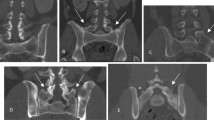Abstract
Introduction
To evaluate the prevalence of subtypes of congenital lumbosacral transition vertebra (LSTV) in young male populations with low back pain (LBP) and their relationship to lumbar disc and facet degeneration.
Materials and methods
1875 patients (male, aged; 18–40 years) with LBP were investigated retrospectively. Standard lumbar MRI protocol of sagittal, and axial T1 weighted images (WI) and T2 WI and coronal short tau inversion recovery (STIR) T2 WI were obtained. Castellvi classification of LSTV were used for subtyping. The level and above the level of LSTV were evaluated for the lumbar disc space and facet degeneration based on grading methods which compares subtype groups with each other.
Results
Prevalence of LSTV was 32% (600 of 1875). The most frequent LSTV types were type I (dysplastic enlarged transverse process; 66.5%) and type II (pseudoarticulation; 21.8%). Eight percent of the patients were type III (fusion) and 3.6% patients type IV (one transverse process fused and one with pseudoarticulation). The most commonly detected LSTV types were type I + II (88%) and all bilateral LSTV types were seen much more than unilateral types (bilateral versus unilateral 63.2%, 33.2%). The LSTV type I highly correlated with the disc degeneration and facet arthrosis. But the groups with higher grade of disc degeneration were type IV and III.
Conclusion
In young male patients with LBP, LSTV was found to be high in frequency and mostly occurred to be subtype I. LSTV type I and associated disk and facet degeneration were found to be remarkable in this group. Coronal T2 STIR images are useful in showing lumbosacral region anomalies and variants, and should be included in the routine lumbar MRI protocol.





Similar content being viewed by others
References
Hughes RJ, Saifuddin A (2004) Imaging of lumbosacral transitional vertebrae. Clin Radiol 59:984–991
Jancuska JM, Spivak JM, Bendo JA (2015) A review of symptomatic lumbosacral transitional vertebrae: bertolotti’s syndrome. Int J Spine Surg 9:42
Bron JL, van Royen BJ, Wuisman PI (2007) The clinical significance of lumbosacral transitional anomalies. Acta Orthop Belg 73:687–695
Delport EG, Cucuzzella TR, Kim N, Marley J, Pruitt C, Delport AG (2006) Lumbosacral transitional vertebrae: incidence in a consecutive patient series. Pain Phys 9:53–56
Konin GP, Walz DM (2010) Lumbosacral transitional vertebrae: classification, imaging findings, and clinical relevance. AJNR Am J Neuroradiol 31:1778–1786
Mahato NK (2013) Redefining lumbosacral transitional vertebrae (LSTV) classication: integrating the full spectrum of morphological alterations in a biomechanical continuum. Med Hypotheses 81:76–81
Bertolotti M (1917) Contributo alla conoscenza dei vizi di differenzazione regionale del rachide con speciale riguardo all assimilazione sacrale della V. lombare. Radiol Med 4:113–144
Castellvi AE, Goldstein LA, Chan DP (1984) Lumbosacral transitional vertebrae and their relationship with lumbar extradural defects. Spine (Phila Pa 1976) 9:493–495
Fujiwara A, Tamai K, Yamato M, An HS, Yoshida H, Saotome K et al (1999) The relationship between facet joint osteoarthritis and disc degeneration of the lumbar spine: an MRI study. Eur Spine J 8:396–401
Weishaupt D, Zanetti M, Boos N, Hodler J (1999) MR imaging and CT in osteoarthritis of the lumbar facet joints. Skeletal Radiol 28:215–219
Farshad-Amacker NA, Lurie B, Herzog RJ, Farshad M (2014) Interreader and intermodality reliability of standard anteroposterior radiograph and magnetic resonance imaging in detection and classification of lumbosacral transitional vertebra. Spine J 14:1470–1475
Long SS, Yablon CM, Eisenberg RL (2010) Bone marrow signal alteration in the spine and sacrum. AJR Am J Roentgenol 195:W178–200
Nardo L, Alizai H, Virayavanich W, Liu F, Hernandez A, Lynch JA et al (2012) Lumbosacral transitional vertebrae: association with low back pain. Radiology 265:497–503
Farshad-Amacker NA, Herzog RJ, Hughes AP, Aichmair A, Farshad M (2015) Associations between lumbosacral transitional anatomy types and degeneration at the transitional and adjacent segments. Spine J 15:1210–1216
Bezuidenhout AF, Lotz JW (2014) Lumbosacral transitional vertebra and S1 radiculopathy: the value of coronal MR imaging. Neuroradiology 56:453–457
Tang M, Yang XF, Yang SW, Han P, Ma YM, Yu H et al (2014) Lumbosacral transitional vertebra in a population-based study of 5860 individuals: prevalence and relationship to low back pain. Eur J Radiol 83:1679–1682
Apazidis A, Ricart PA, Diefenbach CM, Spivak JM (2011) The prevalence of transitional vertebrae in the lumbar spine. Spine J 11:858–862
Luoma K, Vehmas T, Raininko R et al (2004) Lumbosacral transitional vertebra: relation to disc degeneration and low back pain. Spine 29:200–205
Mahato NK (2012) Lumbosacral transitional vertebrae: variations in low back structure, biomechanics, and stress patterns. J Chiropr Med 11:134–135
Mahato NK (2011) Facet dimensions, orientation, and symmetry at L5-S1 junction in lumbosacral transitional states. Spine 36:E569–573
Quinlan JF, Duke D, Eustace S (2006) Bertolotti’s syndrome. A cause of back pain in young people. J Bone Joint Surg Br 88:1183–1186
Milicić G, Krolo I, Anticević D, Roić G, Zadravec D, Bojić D et al (2012) Causal connection of non-specific low back pain and disc degeneration in children with transitional vertebra and/or Spina bifida occulta: role of magnetic resonance–prospective study. Coll Antropol 36:627–663
Sayah A, Jay AK, Toaff JS, Makariou EV, Berkowitz F (2016) Effectiveness of a rapid lumbar spine mri protocol using 3D T2-weighted space imaging versus a standard protocol for evaluation of degenerative changes of the lumbar spine. AJR Am J Roentgenol 3:614–620
Author information
Authors and Affiliations
Corresponding author
Ethics declarations
Conflict of interest
There is no conflict of interest.
Ethical standards
All human studies have been approved by the Medical Ethics Committee of at the local hospital and have therefore been performed in accordance with the ethical standards laid down in the 1964 Declaration of Helsinki and its later amendments. For this type of study formal consent is not required.
Rights and permissions
About this article
Cite this article
Apaydin, M., Uluc, M.E. & Sezgin, G. Lumbosacral transitional vertebra in the young men population with low back pain: anatomical considerations and degenerations (transitional vertebra types in the young men population with low back pain). Radiol med 124, 375–381 (2019). https://doi.org/10.1007/s11547-018-0974-4
Received:
Accepted:
Published:
Issue Date:
DOI: https://doi.org/10.1007/s11547-018-0974-4




